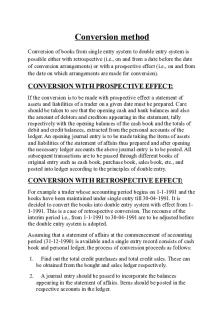Math253 conversion of ellipse equation PDF

| Title | Math253 conversion of ellipse equation |
|---|---|
| Course | Vector Calculus 1 (Introduction To Vectors And Multidimensions) |
| Institution | Lane Community College |
| Pages | 2 |
| File Size | 90 KB |
| File Type | |
| Total Downloads | 46 |
| Total Views | 131 |
Summary
Download Math253 conversion of ellipse equation PDF
Description
Math 253 – conversion of ellipse equation to standard and polar forms We derived the equation of an ellipse with center at the origin and both foci on the x-axis as 2
2
x y + 2 =1 2 a b
with a b . (When b a , the equation describes an ellipse with foci on the y-axis.) The foci are located at (c, 0) and ( −c, 0) with c = a2 − b2 . If the foci are located on some other horizontal line and the center of the ellipse is at the point ( h, k ) instead of (0, 0) , the equation becomes 2
2
( x − h) ( y − k) + =1 2 2 a b
We are going to start with the equation 16 x 2 − 96 x + 25 y 2 = 256 and put it in the above form. Note that B2 − 4 AC = 0 2 − 4(16)(25) = −1600 0 , so this equation does represent an ellipse, not a circle since A C . Now we transform it by completing the square: 16( x 2 − 6 x) + 25 y 2 = 256 16( x2 − 6 x + 9 − 9) + 25 y2 = 256
16( x 2 − 6 x + 9) −144 + 25 y 2 = 256 16( x − 3)2 + 25 y2 = 400
Dividing both sides by 400 and simplifying puts this equation in the form 2
2
( x − 3) y + =1 25 16
So a = 5 , b = 4 , and the center of the ellipse is at (3, 0) . Since c = 52 − 42 = 3 , the foci are 3 units to the left and right of the center point which puts the foci at (0, 0) and (6, 0) . Because one of the foci is at the origin, we can also convert this equation to polar form. We return to the original equation and substitute to convert it to polar coordinates: 16 x 2 − 96 x + 25 y 2 = 256 16( r cos ) 2 − 96( r cos ) + 25( r sin ) 2 = 256 (16 cos2 + 25sin2 ) r2 − (96 cos ) r − 256 = 0
We can use the quadratic formula to solve this equation for r in terms of . We first use the Pythagorean identity sin 2 = 1 − cos2 to rewrite it as (25 − 9 cos 2 ) r 2 − (96cos ) r − 256 = 0
then identify a, b, and c and substitute into the quadratic formula to obtain r=
+96 cos 962 cos2 + 4(25 − 9 cos 2 )256 2(25 − 9 cos 2 )
The cos2 terms inside the square-root cancel, giving us r=
96cos 25600 96cos 160 = 2 2(25 − 9cos ) 2(25 − 9cos2 )
We must take the plus sign if we want r to be positive, although the minus sign also gives us a valid equation in polar coordinates for the same ellipse. We factor the denominator as a difference of squares and simplify r as follows: r=
16 96cos + 160 32(3cos + 5) 16 5 = = = 2(25 − 9cos2 ) 2(5+ 3cos )(5− 3cos ) 5− 3cos 1− 35 cos
Comparing this to the equation on page 5 of section 9.6, we see that this is the equation of an ellipse with eccentricity e = 3 / 5 and one focus at the origin. Note that 0 e 1 ....
Similar Free PDFs

Finding the Foci of an Ellipse
- 3 Pages

Conversion Strategies of ISa
- 1 Pages

Step Two of math equation
- 1 Pages

Conversion of a shelf company
- 5 Pages

Conversion sheet
- 1 Pages

Equation Sheet
- 1 Pages

LAB40- Conversion
- 11 Pages

Conversion method
- 4 Pages

Chemical Equation
- 2 Pages
Popular Institutions
- Tinajero National High School - Annex
- Politeknik Caltex Riau
- Yokohama City University
- SGT University
- University of Al-Qadisiyah
- Divine Word College of Vigan
- Techniek College Rotterdam
- Universidade de Santiago
- Universiti Teknologi MARA Cawangan Johor Kampus Pasir Gudang
- Poltekkes Kemenkes Yogyakarta
- Baguio City National High School
- Colegio san marcos
- preparatoria uno
- Centro de Bachillerato Tecnológico Industrial y de Servicios No. 107
- Dalian Maritime University
- Quang Trung Secondary School
- Colegio Tecnológico en Informática
- Corporación Regional de Educación Superior
- Grupo CEDVA
- Dar Al Uloom University
- Centro de Estudios Preuniversitarios de la Universidad Nacional de Ingeniería
- 上智大学
- Aakash International School, Nuna Majara
- San Felipe Neri Catholic School
- Kang Chiao International School - New Taipei City
- Misamis Occidental National High School
- Institución Educativa Escuela Normal Juan Ladrilleros
- Kolehiyo ng Pantukan
- Batanes State College
- Instituto Continental
- Sekolah Menengah Kejuruan Kesehatan Kaltara (Tarakan)
- Colegio de La Inmaculada Concepcion - Cebu






